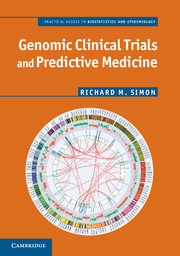Book contents
- Frontmatter
- Contents
- Acknowledgments
- Introduction
- 1 Clinical Trial Basics
- 2 Actionable Prognostic Biomarkers
- 3 Phase II Designs
- 4 Enrichment Designs
- 5 Including Both Test-Positive and Test-Negative Patients
- 6 Adaptive Threshold Design
- 7 Multiple Predictive Biomarkers
- 8 Prospective–Retrospective Design
- Appendix A Statistics Background
- Appendix B Prognostic Classifiers Based on High-Dimensional Data
- References
- Index
2 - Actionable Prognostic Biomarkers
Published online by Cambridge University Press: 05 February 2013
- Frontmatter
- Contents
- Acknowledgments
- Introduction
- 1 Clinical Trial Basics
- 2 Actionable Prognostic Biomarkers
- 3 Phase II Designs
- 4 Enrichment Designs
- 5 Including Both Test-Positive and Test-Negative Patients
- 6 Adaptive Threshold Design
- 7 Multiple Predictive Biomarkers
- 8 Prospective–Retrospective Design
- Appendix A Statistics Background
- Appendix B Prognostic Classifiers Based on High-Dimensional Data
- References
- Index
Summary
Biological measurements used to inform treatment selection are sometimes called biomarkers, but the term invites misinterpretation. Many people think of biomarkers as measures of disease activity, increasing as the disease progresses and decreasing as the disease responds. Such disease biomarkers would have considerable utility as surrogate end-points for clinical trials. Regulatory agencies are, of course, very concerned about accepting a surrogate end-point as a basis for drug approval. Although biomarkers are commonly used as end-points in phase I and phase II clinical trials to establish that a drug inhibits its target or has antidisease activity and for selecting among doses, very stringent criteria have been established for validating surrogate end-points for use in phase III clinical trials. It is generally very difficult to establish that a biological measurement is a valid “disease biomarker.” Our focus here is on prognostic and predictive baseline biomarkers, not on surrogate end-points.
Prognostic markers are pretreatment measurements that provide information about long-term outcome for patients who are either untreated or receive standard treatment. Prognostic markers often reflect a combination of intrinsic disease factors and sensitivity to standard therapy. Predictive biomarkers identify patients who are likely or unlikely to benefit from a specific treatment. For example, HER2 amplification is a predictive biomarker for benefit from trastuzumab. A predictive biomarker may be used to identify patients who are poor candidates for a particular drug; for example, colorectal cancer patients whose tumors have KRAS mutations are poor candidates for treatment with anti-EGFR monoclonal antibodies. Most of the following chapters address the development and validation of predictive biomarkers for guiding the use of a new treatment. In this chapter, however, we discuss the development and validation of prognostic biomarkers that have medical utility for informing treatment decisions.
- Type
- Chapter
- Information
- Genomic Clinical Trials and Predictive Medicine , pp. 7 - 24Publisher: Cambridge University PressPrint publication year: 2013



